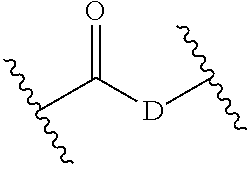Bifunctional rho kinase inhibitor compounds, composition and use
a kinase inhibitor and bifunctional technology, applied in the field of synthetic bifunctional compounds, can solve the problems of not being able to achieve commercially approved therapeutic agents, unable to tolerate undesired side effects, and many patients still lack good control of symptoms
- Summary
- Abstract
- Description
- Claims
- Application Information
AI Technical Summary
Benefits of technology
Problems solved by technology
Method used
Image
Examples
example 1
[0110]
3-(2-Iodoethoxy)-4-methylbenzaldehyde
[0111]A solution of 3-(2-hydroxyethoxy)-4-methylbenzaldehyde in dichloromethane was cooled to 5° C., and 2.2 equivalents of pyridine and 1.1 equivalents of p-toluenesulfonyl chloride were added. The mixture was allowed to warm to room temperature, and stirred until the reaction is complete as judged by HPLC analysis. The mixture was diluted with additional dichloromethane and washed with dilute aqueous HCl, NaHCO3, and brine, then evaporated to a residue.
[0112]The crude tosylate obtained above was dissolved in acetone, and treated with excess sodium iodide with warming. The reaction was allowed to continue until analysis by HPLC shows the conversion to the iodide is complete, after which the mixture was filtered and evaporated to a residue. Chromotography on silica gel afforded the pure title iodide.
example 2
[0113]
(Z)-2-(5-Formyl-2-methylphenoxy)ethyl 7-((1R,2R,3R,5S)-3,5-dihydroxy-2-((R)-3-hydroxy-5-phenylpentyl)cyclopentyl)hept-5-enoate
[0114]A solution of (Z)-7-((1R,2R,3R,5S)-3,5-dihydroxy-2-((R)-3-hydroxy-5-phenylpentyl)-cyclopentyl)hept-5-enoic acid in DMF was treated with 2 equivalents of 3-(2-iodoethoxy)-4-methylbenzaldehyde and 2 equivalents of DBU, and the mixture warmed to 50° C. The reaction was monitored for conversion to the ester by HPLC. When complete the reaction was cooled, diluted with diethyl ether, and washed with dilute aqueous HCl, NaHCO3, and brine, and dried over MgSO4. Evaporation afforded a residue which was chromatographed on silica gel to yield the title ester.
example 3
[0115]
(Z)-2-(5-(((R)-3-(Isoquinolin-5-ylamino)pyrrolidin-1-yl)methyl)-2-methylphenoxy)ethyl 7-((1R,2R,3R,5S)-3,5-dihydroxy-2-((R)-3-hydroxy-5-phenylpentyl)cyclopentyl)hept-5-enoate
[0116]A solution of (R)—N-(pyrrolidin-3-yl)isoquinolin-5-amine and an equimolar amount of (Z)-2-(5-formyl-2-methylphenoxy)ethyl 7-((1R,2R,3R,5S)-3,5-dihydroxy-2-((R)-3-hydroxy-5-phenylpentyl)cyclopentyl)hept-5-enoate in THF was treated with equimolar amounts of glacial acetic acid and sodium triacetoxyborohydride. The reaction was monitored by HPLC for complete conversion of the starting materials to the product, and when complete, was washed with dilute aqueous HCl, NaHCO3, and brine, and dried over MgSO4. Evaporation afforded a residue which was chromatographed on silica gel to yield the title compound, represented as (Drug2-2)-(W-1)-(Link-1)-(Drug1) within Formula I.
PUM
| Property | Measurement | Unit |
|---|---|---|
| Pressure | aaaaa | aaaaa |
Abstract
Description
Claims
Application Information
 Login to View More
Login to View More - R&D
- Intellectual Property
- Life Sciences
- Materials
- Tech Scout
- Unparalleled Data Quality
- Higher Quality Content
- 60% Fewer Hallucinations
Browse by: Latest US Patents, China's latest patents, Technical Efficacy Thesaurus, Application Domain, Technology Topic, Popular Technical Reports.
© 2025 PatSnap. All rights reserved.Legal|Privacy policy|Modern Slavery Act Transparency Statement|Sitemap|About US| Contact US: help@patsnap.com



